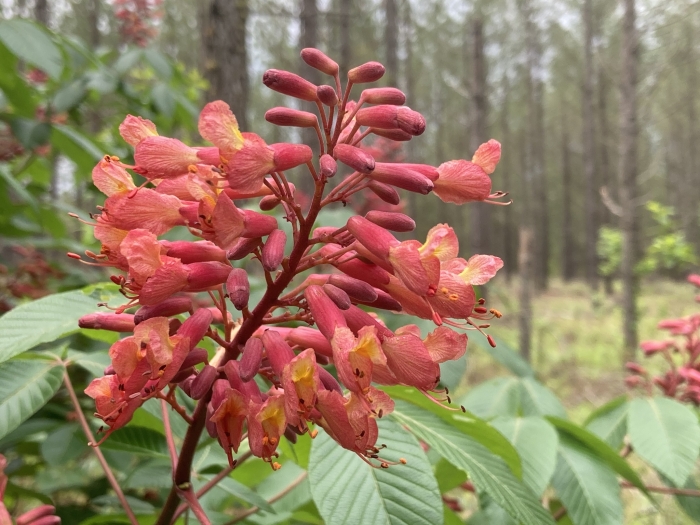Red Buckeye
(Aesculus pavia)
Red Buckeye (Aesculus pavia)
/
/

Hill Craddock
CC BY 4.0
Image By:
Hill Craddock
Recorded By:
Copyright:
CC BY 4.0
Copyright Notice:
Photo by: Hill Craddock | License Type: CC BY 4.0 | License URL: http://creativecommons.org/licenses/by/4.0/ | Rights Holder: Hill Craddock | Publisher: iNaturalist | Date Created: 2021-04-17T12:56:28-07:00 |












































































Estimated Native Range
Summary
Aesculus pavia, commonly known as Red Buckeye, is a deciduous shrub or small tree native to the understory of deciduous forests, often found along streams and in moist woods in the Southeastern United States. It typically grows to a height of 5–8 m (16–26 ft) and can be single or multi-stemmed. The leaves are opposite, palmately compound with 5 leaflets. Red Buckeye is known for its showy, erect panicles of dark red tubular flowers, each 10–18 cm (4–7 in) long, blooming in spring and providing a nectar source for hummingbirds and bees. Following flowering, it produces smooth, round, brown seed capsules containing one to three large, shiny seeds, or "buckeyes." The seeds contain saponins, which are toxic to humans if ingested.
Red Buckeye is valued for its striking red flowers and its ability to attract wildlife, making it a popular choice for naturalistic plantings and wildlife gardens. It is also used as a specimen plant or in shrub borders. This species prefers moist, well-drained soils but can tolerate a range of soil conditions, including clay. While it thrives in full sun to part shade, it requires more water in sunnier sites. Red Buckeye is relatively low maintenance but can be susceptible to leaf blotch and may suffer from leaf scorch in drought conditions. It is not known for aggressive roots or significant disease problems.CC BY-SA 4.0
Red Buckeye is valued for its striking red flowers and its ability to attract wildlife, making it a popular choice for naturalistic plantings and wildlife gardens. It is also used as a specimen plant or in shrub borders. This species prefers moist, well-drained soils but can tolerate a range of soil conditions, including clay. While it thrives in full sun to part shade, it requires more water in sunnier sites. Red Buckeye is relatively low maintenance but can be susceptible to leaf blotch and may suffer from leaf scorch in drought conditions. It is not known for aggressive roots or significant disease problems.CC BY-SA 4.0
Plant Description
- Plant Type: Shrub, Tree
- Height: 15-20 feet
- Width: 15-25 feet
- Growth Rate: Moderate
- Flower Color: Red
- Flowering Season: Spring
- Leaf Retention: Deciduous
Growth Requirements
- Sun: Full Sun, Part Shade
- Water: Medium
- Drainage: Fast, Medium, Slow
Common Uses
Bee Garden, Bird Garden, Butterfly Garden, Deer Resistant, Hummingbird Garden, Rabbit Resistant, Showy Flowers
Natural Habitat
Understory of deciduous forests, often found along streams and in moist woods
Other Names
Common Names: Firecracker Plant , Scarlet Buckeye
Scientific Names: Aesculus pavia , Aesculus pavia var. pavia , Aesculus discolor , Pavia rubra , Aesculus pavia var. discolor , Aesculus austrina , Aesculus versicolor , Aesculus splendens , Aesculus discolor var. mollis , Aesculus rubra
GBIF Accepted Name: Aesculus pavia L.